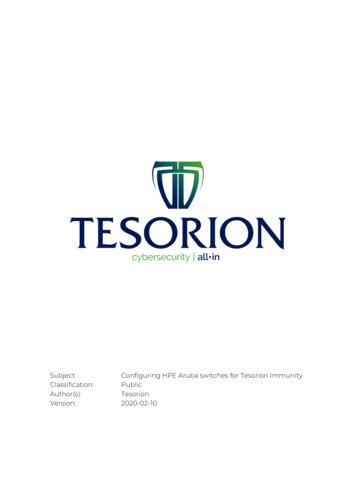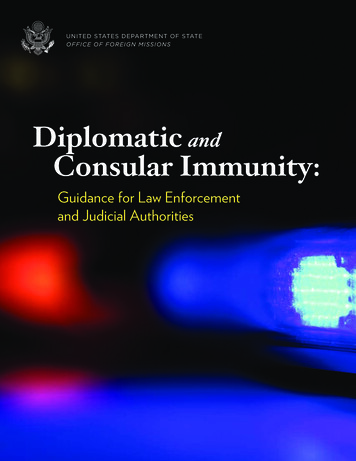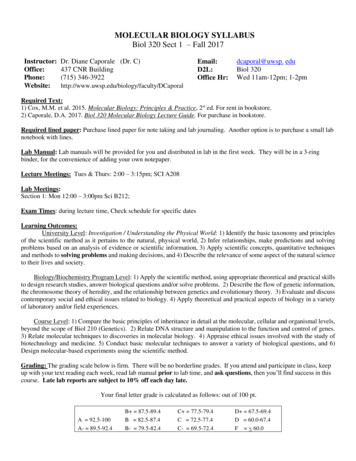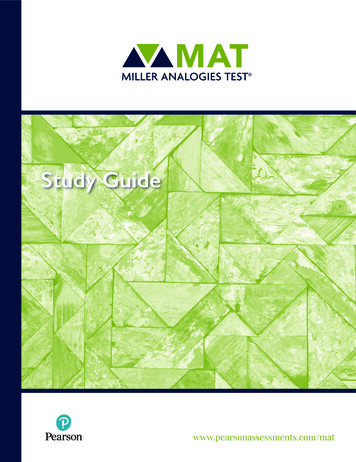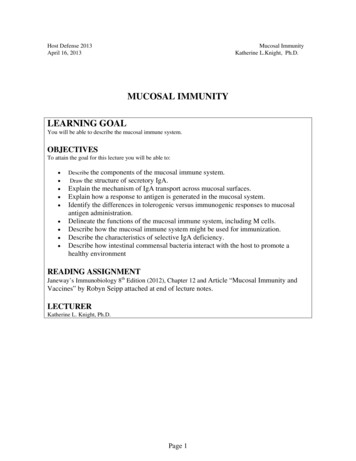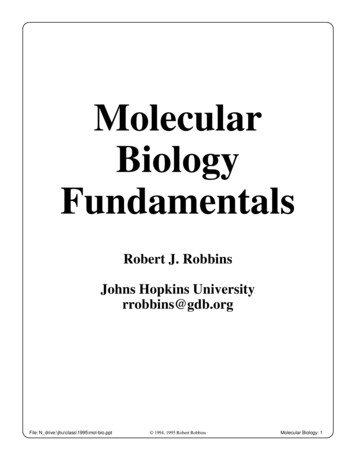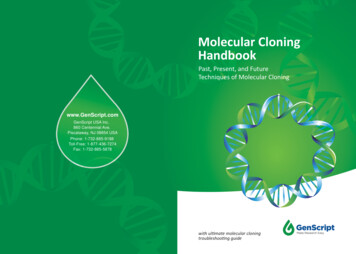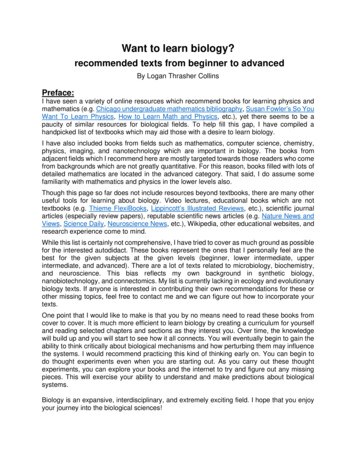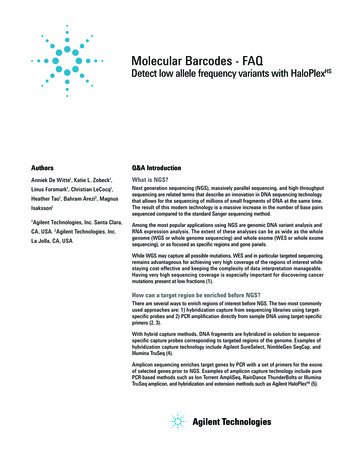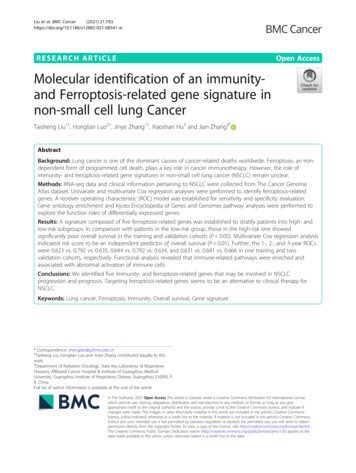
Transcription
Liu et al. BMC Cancer(2021) SEARCH ARTICLEOpen AccessMolecular identification of an immunityand Ferroptosis-related gene signature innon-small cell lung CancerTaisheng Liu1†, Honglian Luo2†, Jinye Zhang1†, Xiaoshan Hu3 and Jian Zhang4*AbstractBackground: Lung cancer is one of the dominant causes of cancer-related deaths worldwide. Ferroptosis, an irondependent form of programmed cell death, plays a key role in cancer immunotherapy. However, the role ofimmunity- and ferroptosis-related gene signatures in non-small cell lung cancer (NSCLC) remain unclear.Methods: RNA-seq data and clinical information pertaining to NSCLC were collected from The Cancer GenomeAtlas dataset. Univariate and multivariate Cox regression analyses were performed to identify ferroptosis-relatedgenes. A receiver operating characteristic (ROC) model was established for sensitivity and specificity evaluation.Gene ontology enrichment and Kyoto Encyclopedia of Genes and Genomes pathway analyses were performed toexplore the function roles of differentially expressed genes.Results: A signature composed of five ferroptosis-related genes was established to stratify patients into high- andlow-risk subgroups. In comparison with patients in the low-risk group, those in the high-risk one showedsignificantly poor overall survival in the training and validation cohorts (P 0.05). Multivariate Cox regression analysisindicated risk score to be an independent predictor of overall survival (P 0.01). Further, the 1-, 2-, and 3-year ROCswere 0.623 vs. 0.792 vs. 0.635, 0.644 vs. 0.792 vs. 0.634, and 0.631 vs. 0.641 vs. 0.666 in one training and twovalidation cohorts, respectively. Functional analysis revealed that immune-related pathways were enriched andassociated with abnormal activation of immune cells.Conclusions: We identified five immunity- and ferroptosis-related genes that may be involved in NSCLCprogression and prognosis. Targeting ferroptosis-related genes seems to be an alternative to clinical therapy forNSCLC.Keywords: Lung cancer, Ferroptosis, Immunity, Overall survival, Gene signature* Correspondence: zhangjian@gzhmu.edu.cn†Taisheng Liu, Honglian Luo and Jinye Zhang contributed equally to thiswork.4Department of Radiation Oncology, State Key Laboratory of RespiratoryDiseases, Affiliated Cancer Hospital & Institute of Guangzhou MedicalUniversity, Guangzhou Institute of Respiratory Disease, Guangzhou 510095, P.R. ChinaFull list of author information is available at the end of the article The Author(s). 2021 Open Access This article is licensed under a Creative Commons Attribution 4.0 International License,which permits use, sharing, adaptation, distribution and reproduction in any medium or format, as long as you giveappropriate credit to the original author(s) and the source, provide a link to the Creative Commons licence, and indicate ifchanges were made. The images or other third party material in this article are included in the article's Creative Commonslicence, unless indicated otherwise in a credit line to the material. If material is not included in the article's Creative Commonslicence and your intended use is not permitted by statutory regulation or exceeds the permitted use, you will need to obtainpermission directly from the copyright holder. To view a copy of this licence, visit http://creativecommons.org/licenses/by/4.0/.The Creative Commons Public Domain Dedication waiver ) applies to thedata made available in this article, unless otherwise stated in a credit line to the data.
Liu et al. BMC Cancer(2021) 21:783BackgroundLung cancer has become the leading deadly malignancyacross the globe [1], with non-small cell lung cancer(NSCLC) accounting for 85% of all cases [2]. Despiteextensive research on molecular targeted therapies andcheckpoint inhibitors, 50% patients die within 1 year ofNSCLC diagnosis, and the 5-year overall survival (OS)rate is 18% [3]. These data indicate that there is an urgent need for not only novel therapeutic research butalso comprehensive analyses to elucidate the molecularmechanisms underlying NSCLC, which should facilitatethe identification of new therapeutic targets.Ferroptosis, an iron-dependent form of programmedcell death, chiefly relies on iron accumulation [4–6].Emerging evidence shows that ferroptosis is closely related to the development of several human diseases, particularly cancer [7–11]. Ferroptosis has been identifiedto be a novel way to induce cancer cell death [12–14].Moreover, ferroptotic cancer cells evidently produce aplethora of oxidized lipid mediators to affect anti-tumorimmunity, and a small proportion of cells undergoingferroptosis are capable of suppressing the immune system, enhancing tumor growth [15]. The induction of ferroptosis can also affect the anti-tumor efficacy ofimmunotherapy, suggesting that the immune system, atleast in part, functions via ferroptosis [16]. However, theFig. 1 Work flow chartPage 2 of 9relationship between NSCLC patient prognosis and immunity- and ferroptosis-related genes remains unknown,making the development of ferroptosis therapy forNSCLC a major challenge.In this study, we collected and analyzed of ferroptosisrelated NSCLC from The Cancer Genome Atlas (TCGA)dataset and Gene Expression Omnibus (GEO) database.Five immunity- and ferroptosis-related differentiallyexpressed genes (DEGs) were identified to establish arisk model. Patients with NSCLC in the GEO databasewere selected as the validation cohort. Gene ontology(GO) enrichment and Kyoto Encyclopedia of Genes andGenomes (KEGG) pathway analyses were performed toexplore the functions and pathways enriched betweenthe high- and low-risk subgroups. Furthermore, to assessprognosis, a nomogram model was developed based onrisk score and clinical features. We believe that our immunity- and ferroptosis-related risk model can serve asa potential gene signature and therapeutic target forNSCLC.MethodsData acquisitionRNA-seq data (n 594) and clinical information relatedto NSCLC were obtained from TCGA dataset (https://tcga-data.nci.nih.gov/tcga/). To validate the findings in
Liu et al. BMC Cancer(2021) 21:783TCGA dataset, the independent cohorts GSE13213 (n 117) and GSE72904 (n 442) from the GEO database(https://www.ncbi.nlm.nih.gov/geo/) were employed.RNA-seq data and clinical information pertaining tothree datasets were independently reviewed by two authors (TX-L and JY-Z) to avoid potential mistakes.DEG identificationSixty ferroptosis-related genes were retrieved from previous literature [14, 17–19]; (Table S1). Sixteen ferroptosisrelated DEGs between tumor and normal tissues wereidentified (Table S1), and 14 ferroptosis-related prognosticgenes were found in TCGA database by excluding normalsamples (n 59) and tumor samples without or with unknown follow-up information (n 26) using the “limma”R package (version 3.6.2, https://cran.r-project.org/) withthe Wilcoxon test. The cut-off criteria were false discoveryrate 0.05 and log2FoldChange 1. Univariate andmultivariate Cox regressions were used to evaluate the relationship between DEGs and OS. Patients were stratifiedinto high- and low-risk subgroups according to their riskscore, which was calculated as follows: risk score j(n Page 3 of 91)Coefj*Xj, wherein Coefj represents the coefficient and Xjrepresents the relative expression level of each DEG standardized by z-score.Development of receiver operating characteristic (ROC)curvesUnivariate Cox regression was used to analyze prognostic DEGs with clinical information. Significant prognostic DEGs (P 0.05) were then analyzed via multivariateCox regression to identify independent prognostic riskfactors. ROC analysis was performed to determine thesensitivity and specificity of the risk model in predictingOS.Principal components analysis (PCA) and t-distributedstochastic neighbor embedding (t-SNE)PCA and t-SNE were used for dimensionality reductionanalysis. Based on expression levels of the genes in thesignature, PCA was performed using the “prcomp” function of the “stats” R package. In addition, t-SNE was performed using the “Rtsne” package to explore thedistribution of different subgroups.Fig. 2 Identification of ferroptosis-related genes in TCGA cohort. (a) A Venn diagram of DEGs associated with OS. (b) Heatmap of five hub genes.(c) Univariate Cox regression analysis of five hub genes. (d) Protein–protein interaction network of ferroptosis-related genes. (e) Correlationnetwork of ferroptosis-related genes
Liu et al. BMC Cancer(2021) 21:783Page 4 of 9Interaction network and enrichment analysisResultsAn interaction network of DEGs was constructed usingSTRING (http://string-db.org/cgi/input.pl). GO enrichment and KEGG pathway analyses were performed toanalyze the functions of differential expressed immunerelated genes using the R software.Identification of prognostic Ferroptosis-related DEGsImmune cells and FerroptosisThe infiltrating score of 16 types of immune cells and 13immune-related functions were calculated via singlesample gene set enrichment analysis (ssGSEA) in the“gsva” R package.Statistical analysisStatistical analysis was performed using R v3.6.2 (https://cran.r-project.org/). Student’s t-test was used to evaluatedifferences between groups. ssGSEA scores between thehigh- and low-risk subgroups were compared with theMann–Whitney test. The Kaplan–Meier method wasused to assess OS and differences were assessed usingtwo-sided log-rank test. Two-sided P 0.05 indicated astatistically significant difference.As shown in Fig. 1, NSCLC from TCGA–LUAD (n 594)and the GEO (GSE13213 and GSE72904, n 559) datasetwere collected and analyzed. The detailed clinical characteristics of these patients are summarized in Table S2.Overall, we identified 16 DEGs (26.7%) between tumorand adjacent normal tissues and 14 (23.3%) prognosticgenes in tumor samples (Fig. 2a). Univariate Cox regression analysis revealed that five of them—ALOX5, DPP4,FANCD2, GCLC, and SLC7A11—were both differentiallyexpressed and correlated with OS (Fig. 2b-c). Interactionnetwork analysis showed that SLC7A11, GCLC, HMOX1,GCLM, G6PD, NQO1, and NOX1 were the significant hubgenes (Fig. 2d-e), suggesting that they are mainly responsible for regulating ferroptosis in NSCLC.Development of a risk model in TCGA cohortTo develop a ferroptosis-related risk model, LASSO regression analysis was performed to construct a riskmodel based on the hub genes (ALOX5, DPP4, FANCD2, GCLC, and SLC7A11). High- (n 297) and low-risk(n 297) risk subgroups using the median cut-off valuewere found (Fig. 3a). PCA and t-SNE results also showedFig. 3 Prognostic analysis of the five-gene signature in TCGA cohort. (a) The risk scores of NSCLC in TCGA cohort. (b) PCA plot of NSCLC. (c) tSNE analysis of NSCLC. (d) Distribution of survival status. (e) Survival analysis in the two risk subgroups. (f) AUC of the risk model
Liu et al. BMC Cancer(2021) 21:783that our risk model could effectively stratify patients(Fig. 3b-c). Moreover, patients in the high-risk groupshowed a higher probability of earlier death than thosein the low-risk group (Fig. 3d). The Kaplan–Meier OScurves revealed that patients in the high-risk group hada significantly worse OS than those in the low-risk group(Fig. 3e). Univariate [hazard ratio (HR): 2.97; 95% CI:1.74–5.06; P 0.001] and multivariate Cox regressionanalyses (HR: 2.70; 95% CI: 1.57–4.64; P 0.001) also revealed that high-risk patients had a significantly worseOS than low-risk patients (Table S3). ROC analysis indicated that the area under the curve (AUC) for our modelreached 0.792 at 1 year, 0.644 at 2 years, and 0.641 at 3years (Fig. 3f). To evaluate the value of our ferroptosisrelated risk model in indicating patient survival withinthe same clinical factor subgroup, patients were furtherstratified based on clinical parameters, such as age ( 65/ 65), gender (female/male), T stage (T1–2/T3–4), Nstage (N0–1/N2–3), M stage (M0/M1), and clinical stage(I-II/III-IV). We found that the risk model couldcategorize patients in the early stage, particularly T1–2,N0–1, M0, and I-II clinical stages, into high- and lowrisk subgroups (Fig. S1). Collectively, these results suggested that the model, composed of five ferroptosisrelated genes, had a strong prognostic power.Page 5 of 9Risk model validationWe validated our risk model in the GSE13213 dataset.In total, 107 patients were stratified into high- and lowrisk subgroups using median risk score values (Fig. 4a).PCA and t-SNE analysis suggested that patients wereproperly classified into high- and low-risk subgroups(Fig. 4b-c). Moreover, patients in the high-risk groupshowed a higher probability of earlier death (Fig. 4d) andhad significantly worse OS than those in the low-riskgroup (Fig. 4e). The predictive power of our risk modelwas satisfactory (1 year, 0.792; 2 years, 0.644; and 3 years,0.641) (Fig. 4f). Furthermore, the risk score was identified to be an independent predictor of OS by both univariate (HR: 5.18; 95% CI: 1.8–14.92; P 0.01) andmultivariate Cox regression (HR: 5.59; 95% CI: 1.79–17.44; P 0.001) analysis (Table S3). To further verifythe stringency of our risk model, the GSE72904 datasetwas employed for model validation. Patients in this dataset were classified as being at a high or low risk; further,the survival of high-risk patients was significantly poorthan that of low-risk ones (P 0.001; Fig. S2a). The predictive power was as follows: 1 year, 0.635; 2 years, 0.634;and 3 years, 0.666 (Fig. S2b). Altogether, these findingssuggested that our risk model had a strong predictivepower in clinical applications.Fig. 4 Validation of the risk model in the GSE13213 dataset. (a) The risk scores in the GSE13213 dataset. (b) PCA plot of GSE13213 dataset. (c) tSNE analysis of of GSE13213 dataset. (d) Distribution of survival status. (e) Survival analysis in the two risk subgroups. (f) AUC of the risk model
Liu et al. BMC Cancer(2021) 21:783Functional enrichment analysisGO enrichment and KEGG pathway analyses were performed to explore the functional roles of DEGs inTGCA–LUAD cohort and the GSE13213 dataset. GOenrichment analysis showed that DEGs were mostlyenriched in several immunity- and ferroptosis-relatedbiological processes and molecular functions (P 0.05;Fig. 5a-b). Further, KEGG pathway analysis showed thatDEGs were mostly enriched in the ferroptosis pathwayand immune-related pathways, such as human T-cellleukemia virus 1 (HTLV-1) infection pathway (P 0.05;Fig. 5c-d). These findings suggested that there existscrosslinking between ferroptosis and tumor immunity inNSCLC.Page 6 of 9To further identify the immune status in different risksubgroups, ssGSEA was used to quantify the infiltratingscores of diverse immune cell subpopulations andimmune-related functions/pathways. For immune cells,we found that the score of activated dendritic cells, immature dendritic cells, antigen-presenting cell costimulation, and human leukocyte antigen (HLA) wassignificantly different between the low- and high-risksubgroups in TCGA cohort (P 0.05; Fig. 6a-b). Thescores of antigen-presenting cell co-inhibition and HLAclass were significantly lower in high-risk patients thanin low-risk patients (P 0.05; Fig. 6b). The GSE13213dataset revealed differences in the scores of HLA classand type-I and -II immune interferon response (P 0.05;Fig. 5 GO enrichment and KEGG pathway analysis. (a-b) GO enrichment analysis in TCGA cohort (a) and the GSE13213 dataset (b). (c-d) KEGGpathways analysis in TCGA cohort (c) and the GSE13213 dataset (d)
Liu et al. BMC Cancer(2021) 21:783Page 7 of 9Fig. 6 The ssGSEA scores between the risk subgroups. Immune scores and immune-related functions of different immune cells of TCGA cohort(a-b) and the GSE13213 dataset (c-d). CCR, cytokine–cytokine receptor. Adjusted P values are shown: ns, not significant; *, P 0.05; **, P 0.01;***, P 0.001Fig. 6c-d). More importantly, the immune score of thesubgroups in both TCGA cohort and the GSE13213dataset was significantly different, especially the score ofmacrophages and mast cells. These data were consistentwith the findings of the functional enrichment analysis.DiscussionCell death is an important aspect of mammalian development and homeostasis and is tightly integrated withthe physiological and pathological state of an organism[20]. Ferroptosis is an iron-catalyzed form of regulatedcell death, and iron accumulation and lipid peroxidationare the main biochemical characteristics of ferroptosis[21]. Recent studies have suggested that ferroptosis playsa key role in cancer development and treatment [22, 23].However, immunity- and ferroptosis-related gene signatures remain largely uninvestigated in lung cancer.Herein we found that 44% ferroptosis-related genes weredifferentially expressed between lung tumor and adjacentnormal tissues and that five ferroptosis-related geneswere significantly associated with OS. A novel riskmodel was developed and validated in GEO dataset byfive ferroptosis-related hub genes.The risk model proposed in this study was composedof five ferroptosis-related genes: FANCD2, GCLC,SLC7A11, ALOX15, and DPP4. FANCD2 is a nuclearprotein involved in DNA damage repair and has been reported to protect against ferroptosis-mediated injury incases of colon adenocarcinoma, clear cell renal cell carcinoma, and low-grade glioma [24–26]. Glutamate
Liu et al. BMC Cancer(2021) 21:783cysteine ligase is composed of the catalytic subunit GCLC,which evidently has a glutathione-independent, noncanonical role in conferring protection against ferroptosis,and this is achieved via the maintenance of glutamatehomeostasis under cystine starvation [27–29]. The inhibition of SLC7A11-mediated cystine uptake can lead tointracellular glutathione deficiency, resulting in ferroptosismediated cell death [17, 21, 30]. ALOX15 is closely associated to lipid ROS production in various types of tissues andtumors [31–33]. DPP4, a mitochondria-encoded gene, is responsible for ferroptosis induction [29].In this study, functional analyses indicated that theidentified DEGs were enriched in several immunerelated pathways, including HTLV-1 pathway, which hasbeen implicated in many types of cancers [34–37].HTLV-1 encodes two viral genes, namely Tax andHTLV-1 bZIP factor (HBZ), which play a critical role inviral transcription and promotion of T-cell proliferation.HBZ, a suppressor of viral transcription, can change theimmunophenotype of infected cells, conferring an effector regulatory T cell (eTreg)-like signature (CD4 CD25 CCR4 TIGIT Foxp3 ) and enhancing the proliferation of this subset [38–40]. We speculate that ferroptosis affects prognosis via the HTLV-1 pathway,which drives the differentiation of Treg. Our findingsalso indicated that in comparison with low-risk patients,tumor-specific cellular immunity was altered in high-riskpatients. Further, the ssGSEA score of HLA class wassignificantly lower in the high-risk group, indicating theimmune suppression in the high-risk patients.This study had several limitations. First, the retrospective data from public databases were used to construct and validate our risk model. Future prospectivestudies are needed to verify its clinical application. Second, the risk model was only associated with ferroptosisrelated genes, the mutation status of oncogenic drivers,such as EGFR and ALK, were not included into the riskmodel, thus the model needs to be further improved.Last, our results relevant to the signature-based riskmodel and immune activity are theoretical and the potential mechanism needs to be further explored.ConclusionsWe herein constructed a novel immunity- and ferroptosisrelated risk model that can serve as a potential gene signature and therapeutic target for NSCLC. Although furtherstudies are warranted to elucidate the mechanisms underlying tumor immunity, we believe that targeting bothimmunity- and ferroptosis-related genes should prove effective for treating lung cancer.AbbreviationsNSCLC: Non-small cell lung cancer; ROC: Receiver operating characteristic;OS: Overall survival; TCGA: The Cancer Genome Atlas; DEGs: Differentiallyexpressed genes; GO: Gene ontology; KEGG: Kyoto Encyclopedia of GenesPage 8 of 9and Genomes; PCA: Principal Components Analysis; t-SNE: t-DistributedStochastic Neighbor Embedding; ssGSEA: Single-sample gene set enrichmentanalysis; HTLV-1: Human T-cell leukemia virus 1; HLA: Human leukocyteantigenSupplementary InformationThe online version contains supplementary material available at nal file 1: Fig. S1. Stratified survival analyses and nomogram ofthe risk model (a–f) Kaplan–Meier survival curves for subgroups stratifiedby different clinical characteristics. Age 65/ 65 years (a), female/male(b), T1–2/3–4 (c), N0–1/2–3 (d), M0/1 (e), and clinical stage I-II/III-IV (f).Additional file 2: Fig. S2. Validation of the five-gene signature in theGSE72904 dataset. (a) OS analysis of patients in the high- and low-risksubgroups. (b) AUC of the five-gene signature.Additional file 3: Table S1. Ferroptosis-related genes.Additional file 4: Table S2. Clinical characteristics of patients in TCGAcohort and the GSE13213 dataset.Additional file 5: Table S3. Results of univariate and multivariate Coxregression analysis.AcknowledgementsNone.Authors’ contributionsJZ, HLL and TSL performed all experiments, prepared the figures, and draftedthe manuscript. TSL and JYZ participated in data analyses and resultinterpretation. XSH, TSL, and JZ designed the study and participated in dataanalyses. All authors have read and approved the manuscript.FundingThis study was supported by grants from the National Natural ScienceFoundation of China (82003212), the Guangzhou Key Medical DisciplineConstruction Project Fund (02–412-B205002–1004042), and the DisciplineConstruction Project of Guangzhou Medical University During the 14th FiveYear Plan (06–410-2107181). The funding bodies played no role in the designof the study and collection, analysis, and interpretation of data and in writingthe manuscript.Availability of data and materialsThe datasets used and/or analysed during the current study available fromthe corresponding author on reasonable request.DeclarationsEthics approval and consent to participateNot applicable.Consent for publicationNot applicable.Competing interestsThe authors declare that they have no competing interests.Author details1Department of Thoracic Surgery, Affiliated Cancer Hospital & Institute ofGuangzhou Medical University, Guangzhou 510095, P. R. China. 2College ofOncology, Guangxi Medical University, Nanning 530021, P. R. China. 3InternalMedicine of Oncology, Affiliated Cancer Hospital & Institute of GuangzhouMedical University, Guangzhou 510095, P. R. China. 4Department of RadiationOncology, State Key Laboratory of Respiratory Diseases, Affiliated CancerHospital & Institute of Guangzhou Medical University, Guangzhou Institute ofRespiratory Disease, Guangzhou 510095, P. R. China.
Liu et al. BMC Cancer(2021) 21:783Received: 11 April 2021 Accepted: 28 June 2021References1. Sung H, Ferlay J, Siegel RL, Laversanne M, Soerjomataram I, Jemal A, et al.Global cancer statistics 2020: GLOBOCAN estimates of incidence andmortality worldwide for 36 cancers in 185 countries. CA Cancer J Clin. 2021;71(3):209–49. https://doi.org/10.3322/caac.21660.2. Wang L, Zhao D, Qin K, Rehman FU, Zhang X. Effect and biomarker ofNivolumab for non-small-cell lung cancer. Biomed Pharmacother. 2019;117:109199. https://doi.org/10.1016/j.biopha.2019.109199.3. Borghaei H, Paz-Ares L, Horn L, Spigel DR, Steins M, Ready NE, et al.Nivolumab versus docetaxel in advanced nonsquamous non-small-cell lungCancer. N Engl J Med. 2015;373(17):1627–39. https://doi.org/10.1056/NEJMoa1507643.4. Hirschhorn T, Stockwell BR. The development of the concept of ferroptosis.Free Radic Biol Med. 2019;133:130–43. 3.5. Dixon SJ. Ferroptosis: bug or feature? Immunol Rev. 533.6. Li J, Cao F, Yin HL, Huang ZJ, Lin ZT, Mao N, et al. Ferroptosis: past, presentand future. Cell Death Dis. 2020;11(2):88. https://doi.org/10.1038/s41419-020-2298-2.7. Eling N, Reuter L, Hazin J, Hamacher-Brady A, Brady NR. Identification ofartesunate as a specific activator of ferroptosis in pancreatic cancer cells.Oncoscience. 2015;2(5):517–32. https://doi.org/10.18632/oncoscience.160.8. Louandre C, Marcq I, Bouhlal H, Lachaier E, Godin C, Saidak Z, et al. Theretinoblastoma (Rb) protein regulates ferroptosis induced by sorafenib inhuman hepatocellular carcinoma cells. Cancer Lett. 2015;356(2 .11.014.9. Hao S, Yu J, He W, Huang Q, Zhao Y, Liang B, et al. Cysteine dioxygenase 1mediates Erastin-induced Ferroptosis in human gastric Cancer cells.Neoplasia. 2017;19(12):1022–32. https://doi.org/10.1016/j.neo.2017.10.005.10. Chen MS, Wang SF, Hsu CY, Yin PH, Yeh TS, Lee HC, et al. CHAC1degradation of glutathione enhances cystine-starvation-induced necroptosisand ferroptosis in human triple negative breast cancer cells via the GCN2eIF2alpha-ATF4 pathway. Oncotarget. 2017;8(70):114588–602. https://doi.org/10.18632/oncotarget.23055.11. Alvarez SW, Sviderskiy VO, Terzi EM, Papagiannakopoulos T, Moreira AL,Adams S, et al. NFS1 undergoes positive selection in lung tumours andprotects cells from ferroptosis. Nature. 2017;551(7682):639–43. https://doi.org/10.1038/nature24637.12. Bebber CM, Muller F, Prieto Clemente L, Weber J, von Karstedt S. Ferroptosisin Cancer cell biology. Cancers. 2020;12(1):164. https://doi.org/10.3390/cancers12010164.13. Liang C, Zhang X, Yang M, Dong X. Recent Progress in Ferroptosis inducersfor Cancer therapy. Adv Mater. 2019;31(51):e1904197. https://doi.org/10.1002/adma.201904197.14. Hassannia B, Vandenabeele P, Vanden BT. Targeting Ferroptosis to Iron outCancer. Cancer Cell. 2019;35(6):830–49. https://doi.org/10.1016/j.ccell.2019.04.002.15. Friedmann Angeli JP, Krysko DV, Conrad M. Ferroptosis at the crossroads ofcancer-acquired drug resistance and immune evasion. Nat Rev Cancer.2019;19(7):405–14. https://doi.org/10.1038/s41568-019-0149-1.16. Stockwell BR, Jiang X. A physiological function for Ferroptosis in tumorsuppression by the immune system. Cell Metab. 2019;30(1):14–5. https://doi.org/10.1016/j.cmet.2019.06.012.17. Stockwell BR, Angeli JPF, Bayir H, Bush AI, Conrad M, Dixon SJ, et al. Ferroptosis:a regulated cell death Nexus linking metabolism, redox biology, and disease.Cell. 2019;171(2):273–85. https://doi.org/10.1016/j.cell.2017.09.021.18. Bersuker K, Hendricks JM, Li Z, Magtanong L, Ford B, Tang PH, et al. TheCoQ oxidoreductase FSP1 acts parallel to GPX4 to inhibit ferroptosis. Nature.2019;575(7784):688–92. https://doi.org/10.1038/s41586-019-1705-2.19. Doll S, Freitas FP, Shah R, Aldrovandi M, Silva MCD, Ingold I, et al. FSP1 is aglutathione-independent ferroptosis suppressor. Nature. 2019;575(7784):693–8. https://doi.org/10.1038/s41586-019-1707-0.20. Kim MJ, Yun GJ, Kim SE. Metabolic Regulation of Ferroptosis in Cancer.Biology (Basel). 2021;10(2):83. https://doi.org/10.3390/biology10020083.21. Dixon SJ, Lemberg KM, Lamprecht MR, Skouta R, Zaitsev EM, Gleason CE,et al. Ferroptosis: an iron-dependent form of nonapoptotic cell death. Cell.2012;149(5):1060–72. https://doi.org/10.1016/j.cell.2012.03.042.Page 9 of 922. Fuchs Y, Steller H. Programmed cell death in animal development anddisease. Cell. 2011;147(4):742–58. https://doi.org/10.1016/j.cell.2011.10.033.23. Thompson CB. Apoptosis in the pathogenesis and treatment of disease.Science. 1995;267(5203):1456–62. https://doi.org/10.1126/science.7878464.24. Fathima S, Sinha S, Donakonda S. Network Analysis Identifies Drug Targetsand Small Molecules to Modulate Apoptosis Resistant Cancers. Cancers(Basel). 2021;13(4):851. https://doi.org/10.3390/cancers13040851.25. Wu G, Wang Q, Xu Y, Li Q, Cheng L. A new survival model based onferroptosis-related genes for prognostic prediction in clear cell renal cellcarcinoma. Aging (Albany NY). 2020;12(14):14933–48. https://doi.org/10.18632/aging.103553.26. Liu Y, Xu Z, Jin T, Xu K, Liu M, Xu H. Ferroptosis in Low-Grade Glioma: ANew Marker for Diagnosis and Prognosis. Med Sci Monit. 7.27. Kang YP, Mockabee-Macias A, Jiang C, Falzone A, Prieto-Farigua N, Stone E,et al. Non-canonical Glutamate-Cysteine Ligase Activity Protects againstFerroptosis. Cell Metab. 2021;33(1):174–89. e7. https://doi.org/10.1016/j.cmet.2020.12.007.28. Sharma P, Shimura T, Banwait JK, Goel A. Andrographis-mediatedchemosensitization through activation of ferroptosis and suppression ofbeta-catenin/Wnt-signaling pathways in colorectal cancer. Carcinogenesis.2020;41(10):1385–94. https://doi.org/10.1093/carcin/bgaa090.29. Zhang Y, Hu M, Jia W, Liu G, Zhang J, Wang B, et al. Hyperandrogenism andinsulin resistance modulate gravid uterine and placental ferroptosis inPCOS-like rats. J Endocrinol. 2020;246(3):247–63. https://doi.org/10.1530/JOE-20-0155.30. Dixon SJ, Patel DN, Welsch M, Skouta R, Lee ED, Hayano M, et al.Pharmacological inhibition of cystine-glutamate exchange inducesendoplasmic reticulum stress and ferroptosis. eLife. 2014;3:e02523. https://doi.org/10.7554/eLife.02523.31. Seiler A, Schneider M, Forster H, Roth S, Wirth EK, Culmsee C, et al.Glutathione peroxidase 4 senses and translates oxidative stress into 12/15lipoxygenase dependent- and AIF-mediated cell death. Cell Metab. 2008;8(3):237–48. https://doi.org/10.1016/j.cmet.2008.07.005.32. Friedmann Angeli JP, Schneider M, Proneth B, Tyurina YY, Tyurin VA,Hammond VJ, et al. Inactivation of the ferroptosis regulator Gpx4 triggersacute renal failure in mice. Nat Cell Biol. 2014;16(12):1180–91. https://doi.org/10.1038/ncb3064.33. Ou Y, Wang SJ, Li D, Chu B, Gu W. A
and Ferroptosis-related gene signature in non-small cell lung Cancer Taisheng Liu1†, Honglian Luo2†, Jinye Zhang1†, Xiaoshan Hu3 and Jian Zhang4* Abstract Background: Lung cancer is one of the dominant causes of cancer-related deaths worldwide. Ferroptosis, an iron-dependent form of programmed cell death, plays a key role in cancer .
